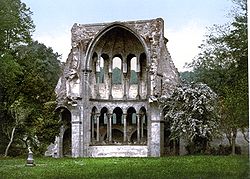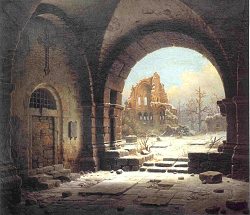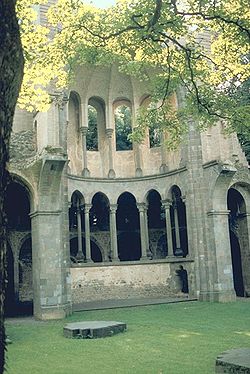
Heisterbach Abbey
Encyclopedia

Siebengebirge
The Siebengebirge is a German range of hills to the East of the Rhine, southeast of Bonn, consisting of more than 40 mountains and hills. It is located in the municipalities of Bad Honnef and Königswinter. It is of volcanic origin and came into being between 28 and 15 million years ago...
near Oberdollendorf
Oberdollendorf
Oberdollendorf is a suburb of Königswinter, a town and summer resort in the Rhein-Sieg district, in North Rhine-Westphalia, Germany. It is situated between the right bank of the Rhine and the Siebengebirge mountain range...
in North Rhine-Westphalia
North Rhine-Westphalia
North Rhine-Westphalia is the most populous state of Germany, with four of the country's ten largest cities. The state was formed in 1946 as a merger of the northern Rhineland and Westphalia, both formerly part of Prussia. Its capital is Düsseldorf. The state is currently run by a coalition of the...
, Germany
Germany
Germany , officially the Federal Republic of Germany , is a federal parliamentary republic in Europe. The country consists of 16 states while the capital and largest city is Berlin. Germany covers an area of 357,021 km2 and has a largely temperate seasonal climate...
.
Petersberg
The tradition of its origin is that a knight named Walther lived as a hermit on the Stromberg, also known as the Petersberg, one of the mountains forming the Siebengebirge. When numerous disciples began to settle near his cell, he built a monastery in 1134, where the community lived according to the Rule of St. AugustineRule of St. Augustine
The Rule of St. Augustine is a religious rule employed by a large number of orders, including the Dominicans, Servites, Mercederians, and Augustinians.-Overview:...
. After the death of Walther however his disciples left the monastery on the Petersberg and built another on the Sulz
Sulz
Sulz is the name of a number of places in Germany, Austria, Switzerland, and Ukraine:*Soulce in the canton of Jura, Switzerland was formerly known as Sulz*Sulz place in the Steiermark, Austria*Sulz in the Steiermark, Austria...
.
In 1189 Philip, Archbishop of Cologne, requested Gisilbert, abbot of the Cistercian Himmerod Abbey
Himmerod Abbey
Himmerod Abbey is a Cistercian monastery in the community of Großlittgen in the Verbandsgemeinde of Manderscheid in the district of Bernkastel-Wittlich, Rhineland-Palatinate, Germany, located in the Eifel, in the valley of the Salm.-First foundation:Himmerod Abbey was founded in 1134 by Saint...
in the Bishopric of Trier, to re-settle the deserted monastery of Petersberg with Cistercians from Himmerod. On 22 March 1189, therefore, twelve Cistercian monks with the newly-appointed Abbot Hermann took possession of it.

Heisterbach
Three or four years later they moved to the foot of the mountain, where they built a new monastery which they called Petersthal or Heisterbach, which was the name which prevailed.The famous basilica
Basilica
The Latin word basilica , was originally used to describe a Roman public building, usually located in the forum of a Roman town. Public basilicas began to appear in Hellenistic cities in the 2nd century BC.The term was also applied to buildings used for religious purposes...
of Heisterbach was begun by Abbot Gerard (1195–1208), and consecrated in 1237 under Abbot Henry (1208–1244). Being built during the period of transition from the Romanesque
Romanesque architecture
Romanesque architecture is an architectural style of Medieval Europe characterised by semi-circular arches. There is no consensus for the beginning date of the Romanesque architecture, with proposals ranging from the 6th to the 10th century. It developed in the 12th century into the Gothic style,...
round arch to the Gothic pointed arch, its style of architecture was a combination of the Romanesque and the Gothic.

Düsseldorf
Düsseldorf is the capital city of the German state of North Rhine-Westphalia and centre of the Rhine-Ruhr metropolitan region.Düsseldorf is an important international business and financial centre and renowned for its fashion and trade fairs. Located centrally within the European Megalopolis, the...
; the monastery and the church were sold and torn down in 1809, and only the apse with the ruins of the choir remains.
Caesarius of Heisterbach
- see main article Caesarius of Heisterbach
Caesarius of Heisterbach, one of the best-known members of the Cistercian Order, was a monk at this abbey (1199–c. 1240). A monument was erected in his honour near the ruins in 1897.
External links
Literature
- Caesarius von Heisterbach: Dialogus Miraculorum – Dialog über die Wunder. Nikolaus Nösges and Horst Schneider eds.,5 vols. Latin and German. Brepols Publishers, Turnhout 2009, ISBN 978-2-503-52940-0

